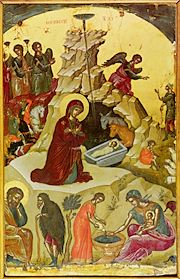Nativity
The Nativity according to the flesh of our Lord, God and Saviour Jesus Christ, also called Christmas, is one of the Great Feasts of the Orthodox Church, celebrated on December 25.
In the fullness of time, our Lord Jesus Christ was born to the Holy Theotokos and Virgin Mary, thus entering into the world as a man and revealing Himself to mankind.
According to the Bible and to Holy Tradition, Jesus was born in the city of Bethlehem in a cave, surrounded by farm animals and shepherds. The baby Jesus was born into a manger from the Virgin Mary, assisted by her husband St. Joseph. St. Joseph and the Theotokos were forced to travel due to a Roman census; the odd location of the birth was the result of the refusal of a nearby inn to accommodate the expecting couple (Luke 2:1-20).
Though three magi from the East are commonly depicted as visiting during the event itself (or, in Roman Catholic tradition, twelve days thereafter), the Bible records the coming of an unspecified number of wise men as being a few years after Jesus' birth (see Matthew 2). In either case, these magi came bearing gifts of gold, frankincense, and myrrh (Matt 2:11). In the hymnography for the feast, these gifts are interpreted to signify Christ's royalty, divinity, and suffering.
Though Jesus' birth is celebrated on December 25, most scholars agree that it is unlikely he was actually born on this date. The choice of December 25 for the Church's celebration of the Nativity is most likely to have been in order to squelch attendance at pagan solstice festivals falling on the same day.
Contents
Celebration of the feast
Nativity fast
The cycle starts with a fast of forty days that precedes the feast. It is called the Nativity fast or Advent. For the faithful, it is a time to purify both soul and body to enter properly into and partake of the great spiritual reality of Christ's Coming, much like the preparation for the fast of the Lord's Resurrection.
The beginning of the fast on November 15 is not liturgically marked by any hymns, but five days later, on the eve of the Feast of the Presentation of the Theotokos, we hear the first announcement from the nine "Irmoi" of the Christmas Canon: "Christ is born, glorify Him!"
This period includes other special preparatory days announcing the approaching Nativity: St Andrew's Day, November 30; St Nicholas Day, December 6; the Sunday of the Forefathers; and the Sunday of the Fathers.
December 20th begins the Forefeast of the Nativity. The liturgical structure is similar to the Holy Week preceding Pascha. The Orthodox Church sees the birth of the Son of God as the beginning of the saving ministry which will lead Him, for the sake of man’s salvation, to the ultimate sacrifice of the Cross.
Eve of the Nativity
On the eve of the Nativity, the Royal Hours are read and the Divine Liturgy of St. Basil the Great is served with Vespers. At these services the Old Testament prophecies of Christ's birth are chanted.
Christmas vigil
The Vigil of Christmas begins with Great Compline because Vespers has already been served. At Compline there is the singing of the Troparion and Kontakion of the feast with special hymns glorifying the Saviour's birth. There are also the special long litanies of intercession and the solemn blessing of the five loaves of bread together with the wheat, wine, and oil. The faithful partake of the bread soaked in the wine and are also anointed with the oil. This part of the festal vigil, which is done on all great feasts, is called in Slavonic the litya and in Greek artoklasia, or the breaking of the bread.
The order of Matins is that of a great feast. Here, for the first time, the full Canon "Christ is born," is sung while the faithful venerate the Nativity icon.
Christmas Liturgy
Concluding the celebration of the Nativity of Christ is the Liturgy. It begins with psalms of glorification and praise instead of the three normal Antiphons. The troparion and kontakion mark the entrance with the Book of the Gospels. The baptismal line from Galatians 3:27 once again replaces the Thrice-Holy. The Epistle reading is from Galatians 4:4-7, the Gospel reading is the familiar Christmas story from Matthew (2:1-12), and then the liturgy continues in the normal fashion.
Twelve days of Christmas
The second day of the feast starts a two-day celebration of the Synaxis of the Theotokos. Combining the hymns of the Nativity with those celebrating the Mother of God, the Church points to Mary as the one through whom the Incarnation was made possible. St Stephen, the First Martyr, is also remembered on these two days.
On the Sunday after Christmas the Church James the Brother of Our Lord, David the King, and Joseph the Betrothed.
Eight days after the Nativity, is the feast of Circumcision of our Lord.
The period of Christmas rejoicing extends to Epiphany during which time the Christmas songs are sung and fasting and kneeling in prayer are not called for by the Church. Throughout this time, it is the custom of some Orthodox Christians to greet each other with the words: "Christ is Born!" and the response: "Glorify Him!"
Hymns
- Your Nativity, O Christ our God,
- Has shone to the world the Light of wisdom!
- For by it, those who worshipped the stars,
- Were taught by a Star to adore You,
- The Sun of Righteousness,
- And to know You, the Orient from on High.
- O Lord, glory to You!
Kontakion (Tone 3)
- Today the Virgin gives birth to the Transcendent One,
- And the earth offers a cave to the Unapproachable One!
- Angels with shepherds glorify Him!
- The wise men journey with a star!
- Since for our sake the Eternal God was born as a Little Child!
